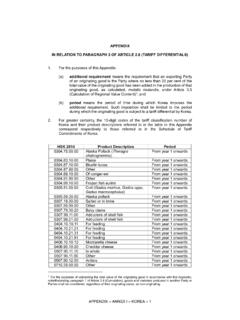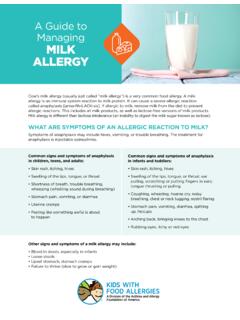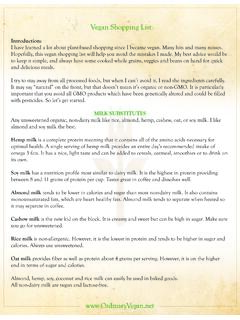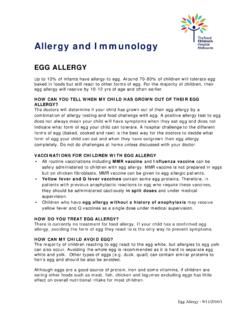Transcription of NASEM Nutrient Requirements of Dairy Cattle: Dry Cows ...
1 Professor of Animal SciencesUniversity of Illinois Urbana-ChampaignJim DrackleyNASEM Nutrient Requirements of Dairy Cattle: Dry Cows, Calves, and HeifersDry and Transition CowsChanges from NRC 2001 Up-to-date lit review on: Metabolic disorders Ruminal changes during transition Colostrum composition DMI equations Gestation requirement model structure Effects of dry cow nutrition on milk production Specific Requirements of close-up (pre-fresh) where justifiedNEL concentration of diets NEL NRC 2001 Mcal/kg( Mcal/lb) NEL NASEM 2021 Mcal/kg( )Ingredient% ofDMCorn gluten and kg, 270 DCC, kg/d DMIR equirements also increase so net change in energy balance is minimalEstimated DMI by NASEM 2021 Equations include parity, diet NDF, and week prepartum Week used because of uncertainty of calving date Insufficient data for true meta-analysis Insufficient data to evaluate interactions among parity, diet, and time prepartum Data from 2001 and all newer data available were used Almost all experiments used high forage diets.
2 Diets with byproduct NDF sources not representedEstimating DMI using NASEM 2021 Cows (% of BW):= [( NDF) week] week2where week = week from calving ( , it is negative)If cow > 3 wkfrom parturition, week = -3 Heifers: Cow equation new data, therefore average parity effect from 2001 was retainedEstimated DMI by cows using NASEM 2021 New DMI equationsFor far-off dry cows (>3 wkprepartum) DMI will be between and 2% of BW Negatively correlated with dietary NDFFor close-up dry cows (<3 wkprepartum) DMI starts decreasing ~ wkprepartum Rate of decline negatively correlated with dietary NDF At about wk1 prepartumDMI about the same for all NDF ( of BW)Calculation of gestation Requirements Mass model for conceptus starts at d 10 of gestation (compared with d 190 in NRC 2001) Function of maternal BW (heifer has smaller calf)
3 Energy = Mcal/kg CP = 125 g/kgGestation energy and protein requirementsGestation NEL, Mcal/dGestation MP, g/dDay of gestationNRC 2001 NASEM 2021 NRC 2001 NASEM starch, fiber, and energy Almost impossible to separate these effects ( , as NDF goes up starch and NEL usually go down) Increasing prefreshenergy (more starch, less NDF): Increases prepartumDMI Generally little effect on postpartum DMI Most studies show no effect on milk yieldUse of pre-fresh diet to adapt rumen To help rumen deal with higher starch postpartum diet Based on available data, benefits of feeding a diet of moderate starch and fiber to transition ruminal cells and rumen tissue morphology from a high-forage diet to a higher-starch lactation diet are not evident. Dry cow dietary protein and milk production Most studies fed treatments during entire dry period, not just pre-fresh milk and milk composition during first 3 wkto 17 wkwere the primary outcome variables In few studies, diets were as low as 10% CP without effect on milk production (cows) Diet with 10% CP prepartumremained in protein balance at d -10 (Putnam and Varga, 1998)Dry cow dietary CP and milk productionMeta-analysis (Lean et al.)
4 , 2013)12 studies, 26 treatment comparisonsControl diets: to CP (avg. = )Treatment diets: to CP (avg. = ) milk yield first 28 d to 120 d (avg= 65 DIM)Average increase in milk = kg/d ( to + kg/d)Dry cow dietary MP and milk productionMeta-analysis (Husnainand Santos, 2019)27 comparisons for heifers97 comparisons for cowsMostly prefreshtreatment comparisonsDiets: 9 to 21% CP (avg. = )6 to 10% MP (avg. 13% for cows; to )MP calculated according to NRC 2001 Dry cow dietary CP and milk production No difference in milk yield for cows milk protein increased 60 g/1000 g MP intake in cows producing >36 kg/d milk Increased milk and milk protein in first lactation cows(Husnainand Santos, 2019) NASEM 2001 modelFar-off dry cow and heifer ~11% CP ( MP) will ~meet requirement 12% CP ( MP) recommended because of limited data and potentially inadequate RDPC lose-up cow and heifer ~13% CP ( MP)
5 Will meet requirement Might not be optimum for heifers Model ignores MP for colostrum and immune functionSpecific minerals/vitamins for transition cows Negative DCAD, Ca, P, Mg for hypocalcemia Higher vitamin E based on mastitis, RP, and metritis No other specific requirementsCalvesGeneral features of calf model Based on energy-allowable growth. Protein Requirements calculated as maintenance plus body N deposition at energy-allowable growth rate. Minerals and vitamins calculated based on factorial Requirements (new) Prediction of retained energy (RE, , net energy) is central to model of Observed and Predicted ADG for CalvesDrackley, unpublished 2021111 treatment means from the daily gain, kg/dTertileObservedNRC, onlyMilk plus starterWeanedAverage daily gain, kg/dDiet typeObservedNRC, 2001 Problems with NRC 2001 energy equations Data from which ToullecME equation was derived came from studies with heavier veal calves fed milk only.
6 Efficiency of converting ME to RE is too high for lighter weight growing calves depositing primarily determine RE we must know composition of BW gainComparative slaughter studies:Measured RE = ME intake Heat productionSince publication of NRC 2001, several body composition studies have been reported Database of 255 calves (7 studies: Cornell, Illinois, Virginia Tech) with full body composition and changes from baseline (RE) 6 published, 1 thesis 6 Holstein, 1 Jersey 2 with starter, 5 without Used to derive: maintenance energy relationships between retained energy and empty body weight gain and metabolic body size efficiencies of ME use nitrogen depositionEffects of cold and heat stress on maintenance Maintenance ME = Mcal/kg + day for each degree decrease in environmental temperature ( C) below the lower critical temperature or above the upper critical temperatureNext need to derive an equation linking retained energy (NEg) to body weight gain Ultimately allows linking dietary energy (ME) supply to predicted BW gain Equation selected was:RE, Mcal/d = ( , kg/d) (EBW, ) Can rearrange to calculate EBG (and then ADG).
7 EBW gain (kg/d) = RE, Mcal/d / ( , kg)1 of ME use for gain, milk only from model development datasetEfficiency of ME use for gain, milk only On a metabolic body weight basis = 46% Summary of older studies, basis of NRC 2001 = 69% INRA, 2019 = 55% Use 55% as compromise to represent all calves Efficiency for calves fed milk plus starter is lowerEfficiency of ME use from starterNEg, Mcal/kg DM = ( ME) - ( ME2) + ( ME3) - al. (2016) Over typical starter ME range ( , to Mcal/kg), RE:ME varies from to of mixed diet ( milk plus starter) is additiveMetabolizableprotein for maintenance Relatively small Calculated similarly to NRC, 2001 except with addition of scurf protein and reduced efficiency of use ( vs )Nitrogen Composition of the GainNRC 2001 used a mean value of 30 g N/kg liveweightgain (Blaxterand Wood, 1951; Roy, 1970.)
8 Donnelly and Hutton, 1976) Equivalent to 188 g CP/kg LWGRe-evaluated from the new model development database using the Beef NRC equation format:NPg= ( EBW gain, kg/d) + ( (RE, Mcal/d / EBW gain, kg/d))Efficiency of use of absorbed amino acidsUsed combined efficiency of maintenance and growth of (Lapierre et al)Compared with in NRC, 2001 Energy and protein for 50-kg Holstein calf (thermoneutralconditions), based on the NASEM equations:ADGDMIMECPCP(kg/d)(kg/d)(Mcal/ d)(g/d)(% of DM) , 2021unpublishedObserved minus predicted values for ADG (kg/d) from 401 literature treatment means, with residuals plottedComparison of actual mean ADG from 111 treatment means from the literature with values predicted by the current model or the previous (NRC, 2001) modelComparison of actual mean ADG from 111 treatment means from the literature with values predicted by the current model or the previous (NRC, 2001) modelComparison of new system with NRC, 2001 For a 50-kg calf fed kg of milk replacer (20/20) and consuming kg of starter daily Predicted growth.
9 New system = kg/d NRC, 2001 = kg/dComparison of new system with NRC, 2001 For a 50-kg calf fed kg of milk replacer (28/20) and consuming kg of starter daily Predicted growth: New system = kg/d NRC, 2001 = kg/dComparison of new system with NRC, 2001 For a 50-kg calf fed kg of milk replacer (26/17) and consuming kg of starter daily Predicted growth: New system = kg/d NRC, 2001 = kg/dPrediction equations for starter intake Compiled database of 26,952 observations from 1,356 calves from 28 studies carried out in 4 states and the Netherlands (Georgia, n = 168; Illinois, n = 1,925; Minnesota, n = 6,052; Ohio, n = 16,457; and the Netherlands, n = 2,350). An external data set (n = 8,891 individual observations, 9 studies) was developed to evaluate the models using data from four states (Iowa, n = 6,332; New Hampshire, n = 1,519; New York, n = 892; Virginia, n = 148).
10 Prediction equations for starter intake (cont d) Equation selected for calves in temperate conditions:Starter DMI (g/d) = + (BW ) + (MeiLD ) + (Fpstarter ) + (FPstarter2 ) ( Fpstarter MEiLD) RMSE of 262 g/d, CCC of equations for starter intake (cont d) For calves in subtropical environments, equations to predict starter intake were developed using individual animal data (n = 3,491 observations from 853 calves) from 15 studies carried out in the United States and Brazil (Florida, n = 1,127; Georgia, n = 179; Brazil, n = 2,185). An independent data set (n = 479 individual observations, five studies) was used to evaluate the models using data from the United States and Brazil (Georgia, n = 96; Brazil, n = 383).Prediction equations for starter intake For calves in subtropical environments, equation selected:Starter DMI (g/d) = (1 + (exp( FPstarter))) 1 + ( BW) ( MEiLD) RMSE of 222 g/d, CCC of When users enter environmental temperature >35 C, this equation is in recommended mineral concentrationsCompared to NRC, 2001: Ca lower for MR but similar for starter and grower.








